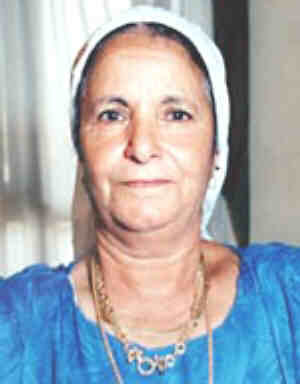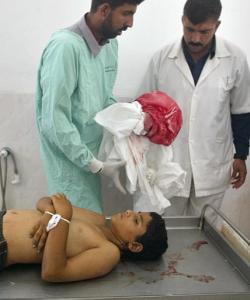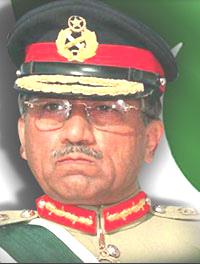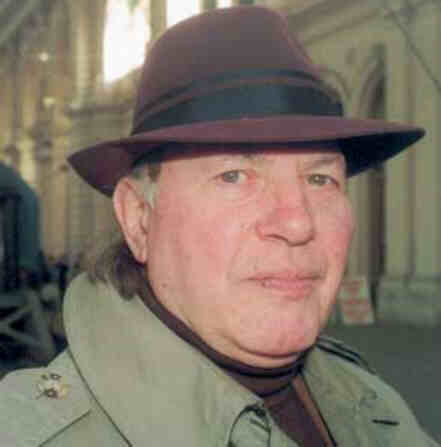 Deaths
which occurred on an October 10:
^top^ Deaths
which occurred on an October 10:
^top^
2002 Israeli woman Sa'ada
Aharon, 71 [photo >], and suicide bomber
Rafik Hamad, 31, Hamas terrorist, who had targeted a suburban bus
stop near Tel Aviv's Bar Ilan University during morning rush hour. Hamad
tried to board through the back door a Daw Bus of No. 87 line from Petah
Tikva to Tel Hashomer, which had pulled into a stop near Bar-Ilan Junctiona.
The bus was filled with some 50 passengers, mostly soldiers and students.
When the driver closed the doors, Hamad slipped and fell onto the sidewalk,
hurting his head. The driver and a passenger got off the bus to help the
man, but when they opened his shirt thay saw that he was wearing a bomb
belt, so they grabbed his hands and shouted for people to clear the area.
"He tried to move his legs," driver Baruch Neuman, 50, said. "We began to
fear that we would explode with him...so we decided together to let go of
his hands and flee." The bomber then stood and ran about 20 meters from
the bus toward a crowd of bystanders and set off his explosives at 07:48.
12 persons are injured. The Reuters body count of the al-Aqsa intifada is
now “at least” 1603 Palestinians and 604 Israelis.
 2002
Abdel Hadi Hamaida, 12 [<photo], and another
Palestinian boys, aged 18, shot by Israeli soldiers raiding Rafah
in the Gaza strip at the border with Egypt, who were demolishing a home
and fired to keep people away. 2002
Abdel Hadi Hamaida, 12 [<photo], and another
Palestinian boys, aged 18, shot by Israeli soldiers raiding Rafah
in the Gaza strip at the border with Egypt, who were demolishing a home
and fired to keep people away.
2002 Sixteen persons after
bomb explodes in Grozny, Chechnya, on the second floor of a puppet
police station, just under a third-floor meeting of police officers in the
evening. Most of the dead are police officers, killed by the explosion and
the collapse of the 4-story building. The bomb was probably planted by a
independentist mole within the puppet police.
2001 Some 30
men, massacred by right-wing outlaw paramilitaries of the AUC (Autodefensa
Unida de Colombia), in Buga, a village 260 km southwest of Bogotá.
They took the people out of two buses and from their homes. They separated
the women, old people and children, and then shot each of the men in the
head after accusing them of aiding leftist rebels.
2002 Keith
Uncapher, computer scientist born on 01 April 1922. When director
of Rand Corporation's computer science division he led a project on data
packet switching for networks. Then, in 1972, he founded, at the University
of California's School of Engineering, the Information Sciences Institute,
which worked on the development of the Internet's system of domain names
(such as .com, .org).
 2002
Baby Oryx, recently born in Kenya's Samburu National Reserve, starved
to death separated from its mother after becoming the fifth newborn oryx
kidnapped by lioness Kamuniak (“blessed one” in the local Samburu
language), who then eats its corpse. Kamuniak has been very motherly and
protective toward her adopted baby oryxes, fending off other animals. But
although on occasion she did let mother oryxes nurse their babies for brief
periods, this was not enough to prevent starvation. Kamuniak was starving
herself too, as she did not take enough time off for hunting while she was
protecting a baby oryx. Animal behaviorists believe Kamuniak suffers from
a mental illness. 2002
Baby Oryx, recently born in Kenya's Samburu National Reserve, starved
to death separated from its mother after becoming the fifth newborn oryx
kidnapped by lioness Kamuniak (“blessed one” in the local Samburu
language), who then eats its corpse. Kamuniak has been very motherly and
protective toward her adopted baby oryxes, fending off other animals. But
although on occasion she did let mother oryxes nurse their babies for brief
periods, this was not enough to prevent starvation. Kamuniak was starving
herself too, as she did not take enough time off for hunting while she was
protecting a baby oryx. Animal behaviorists believe Kamuniak suffers from
a mental illness.
Kamuniak kidnapped her first baby
oryx on 22 December 2001 and let its mother nurse it enough, at least, to
keep alive. On 07 January 2002, a male lion killed this oryx while the lioness
slept.
On 14 February 2002 Kamuniak
kidnapped a second baby oryx [< photo], but rangers soon
took it away to the Nairobi animal orphanage, because it seemed too young
and weak to survive away from its mother.
On 31 March 2002, Kamuniak kidnapped a third baby oryx, but after several
days of peaceful companionship. the oryx calf took off on its own.
On 23 May 2002, Kamuniak kidnapped a
fourth baby oryx, about 8 days old, at the foot of Koitogor Hills, several
hundred meters from Larsens Camp. This baby oryx was rescued by its mother
early the next day while the lioness went hunting.
2001 Sabir,
14, and Javed Iqbal, poisoned in their prison cells, in Pakistan,
prison authorities alleging it to be suicide. In March 2000, the two had
been sentenced to be strangled, cut into 100 pieces and thrown into acid,
for having murdered 100 children in that same way. On 06 October 2001, Pakistan's
highest Islamic Court had agreed to hear their appeal.
2000
Sirimavo Ratwatte Dias Bandaranaike, política y primera ministra
de Sri Lanka.
2000 Sami Abu Jezar, 12; one of several
Palestinians killed by Israeli soldiers during riots of the Aqsa intifadah.
2000 Doctor Miguel Nassif García,
in Colombia, of injuries sustained while he was held captive by the Ejército
de Liberación Nacional, who had captured him with others on 17 September
2000 on the road between Cali and Buenaventura, department of Valle del
Cauca.
1999 Morris West, escritor australiano.
1991 Pío Cabanillas Gallas, político y ex ministro
español.
1986 Antonio di Benedetto, escritor y periodista
argentino.
1985 Yul Brynner, 70, actor (King &
I), of cancer
1985 Orson Welles, 70, actor (Citizen
Kane)
1982 Bernardo Canal Feijóo, escritor, dramaturgo,
poeta, pensador y ensayista argentino.
1975 Levinson,
mathematician
1963 Some 3000 die from flooding from
a burst dam in Italy.
1959 Prince Friedrich of Liechtenstein
1958 Maurice de Vlaminck, French Fauvist
painter born on 04 April 1876. — Vlaminck also wrote several novels.
Des romans de Vlaminck: D’un Lit dans l’autre — Fausse couleur
— Moyen Age sans cathédrale — La haute-Folie — Cartes sur
table. Autres livres de Vlaminck (mémoires, pensées):
Portraits avant décès — Désobéir — Tournant dangereux —
Le Ventre ouvert. — (illustré) Le Boeuf. —
(poésies) Histoires et poèmes de mon époque, avec cinq bois gravés
de l’auteur. . — MORE
ON VLAMINCK AT ART “4” OCTOBER
with links to many images.
1946 Pfeiffer,
mathematician
1945 Joseph Darnand,
48 ans, exécuté.
Né en 1897 à Coligny (Ain), il participe héroïquement à la Grande
Guerre. Il adhère à l'Action française en 1925 et rejoint en 1928
les Croix de Feu, la Cagoule, et adhère au Parti populaire français
de Doriot en 1936. Jugeant la Légion française des combattants trop
modérée, il crée en 1941, dans les Alpes-maritimes, le Service d'ordre
légionnaire (SOL), mouvement paramilitaire, antisémite, reconnu par
Pétain. Le SOL devient la Milice française en 1943 qui doit défendre
la révolution nationale aux côtés de l'Allemagne. Darnand prête serment
à Hitler et entre dans la Waffen SS. Laval le couvre et la Milice
développe le terrorisme, devenu légal, contre les maquis. En septembre
1944, il gagne Sigmaringen et intégre la Milice dans la division SS
Charlemagne. Arrêté, il est condamné à mort par la Haute Cour
de Justice. |
1944 Some 8000 Gypsy children,
gassed at Auschwitz ^top^
800 Gypsy children, including more
than a hundred boys between 9 and 14 years old are systematically
murdered. Auschwitz was really a group of camps, designated I, II,
and III. There were also 40 smaller "satellite" camps. It was at Auschwitz
II, at Birkenau, established in October 1941, that the SS created
a complex, monstrously orchestrated killing ground: 300 prison barracks;
four "bathhouses," in which prisoners were gassed; corpse cellars;
and cremating ovens. Thousands of prisoners were also used as fodder
for medical experiments, overseen and performed by the camp doctor,
Josef Mengele ("the Angel of Death").
A mini-revolt took place on October 7, 1944. As several hundred Jewish
prisoners were being forced to carry corpses from the gas chambers
to the furnace to dispose of the bodies, they blew up one of the gas
chambers and set fire to another, using explosives smuggled to them
from Jewish women who worked in a nearby armaments factory. Of the
roughly 450 prisoners involved in the sabotage, about 250 managed
to escape the camp during the ensuing chaos. They were all found and
shot. Those co-conspirators who never made it out of the camp were
also executed, as were five women from the armaments factory--but
not before being tortured for detailed information on the smuggling
operation. None of the women talked.
Gypsies, too, had been singled out for brutal treatment by Hitler's
regime early on. Deemed "carriers of disease" and "unreliable elements
who cannot be put to useful work," they were marked for extermination
along with the Jews of Europe from the earliest years of the war.
Approximately 1.5 million Gypsies were murdered by the Nazis. In 1950,
as Gypsies attempted to gain compensation for their suffering, as
were other victims of the Holocaust, the German government denied
them anything, saying, "Gypsies have been persecuted under the Nazis
not for any racial reason but because of an asocial and criminal record.”
They were stigmatized even in light of the atrocities committed against
them. |
1847 Taro Katsura, 11th, 13th, and 15th Prime Minister
of Japan (02Jun1901-07Jan1906, 14Jul1908-30Aug1911, 21Dec1912-20Feb1913),
born on 28 November 1847 in Yamaguthi Prefecture.
1895 Hjalmar
Hjorth Boyesen, author. BOYESEN ONLINE: Boyhood
in Norway, Boyhood
in Norway, Tales
from Two Hemispheres, Tales
from Two Hemispheres, contributor to Goethe's Wilhelm
Meister's Apprenticeship
1886 David L Yule
1st Jewish US senator
1884 Jan Rutten, Dutch artist
born on 31 July 1809.
1871 The last of 300 dead from
Great Fire of Chicago as it is put out by rain
^top^
Two days ago, on Sunday evening at nine o'clock, the Great
Fire of Chicago broke out in southwest Chicago, possibly started
by a cow kicking over an oil lamp in a barn owned by Patrick and Katherine
O'Leary. Within hours the conflagration, driven by a strong wind out
of the southwest, engulfed the center of the city, and around midnight
jumped the Chicago River, burning the southern portion of the city
to the ground by daybreak.
As
thousands of panicked Chicagoans fled to the north, the fire pursued
them, and by Monday the flames had reached Fullerton Avenue, then
the northern-most limit of the city. This morning, Tuesday, a saving
rain begins to fall, and the flames finally die out, leaving Chicago
a smoking ruin, with some 300 dead, 17'450 buildings destroyed in
an area over 6-km-long and 1-km-wide, the original Emancipation Proclamation
destroyed, and 98'500 people left homeless. The material damage is
estimated at $200 million.
Several
factors contributed to the severity of the Great
Chicago Fire. The bustling Midwestern city was built primarily
of wood, and several woodworking industries operated within the city
limits. Also, rainfall during the preceding months had totaled just
one fourth of normal precipitation while early October was unseasonably
warm.
Despite the devastation,
Chicago would rise again and continue to be the economic center of
the American West for decades to come. While, geographically, Chicago
is a midwestern city, economically it is the unofficial regional capital
and economic center of the American West. Because of its location
on the western edge of a system of lakes, rivers, and canals that
link the city to the East, Chicago was the natural destination for
both western raw materials moving East and eastern manufactured goods
moving West.
After the Civil
War, Chicago quickly eclipsed St. Louis as the primary trading hub
between the US East and West, and the city's fate was inextricably
tied to the rapidly growing settlement and development of western
natural resources. Millions of dollars worth of cattle, lumber, swine,
and grain that had originated in the plains of Wyoming or the mountains
of Montana were channeled through the massive freight yards, slaughterhouses,
and grain elevators of Chicago. A look at a map of the US during the
1880s reveals that, by the late 19th century, all railroads led to
Chicago. Although the Great Fire of 1871 destroyed Chicago's downtown,
it left most of the city's essential industrial infrastructure in
place. Its towering grain elevators and vast stockyards continued
to collect the growing output of the West, process it into pork sausages
or two-by-fours, and send it onward to the insatiable markets of the
East. |
1837 Charles Fourier, socialista utópico francés.
1780 Some 20'000 die in Great Hurricane of 1780 in Caribbean
1746 Johann Christian Sperling, Danish artist born
in 1690 or 1691.
1708 David
Gregory, mathematician
1665 William Guthrie,
author. GUTHRIE ONLINE: The
Christian's Great Interest
1419 Jean sans Peur, duc de
Bourgogne.
Sur
le pont de Montereau, face à face, le dauphin Charles (22 Feb 1403
– 22 Jul 1461; qui à la mort de son père Charles
VI le Bien-Aimé ou l'Insensé le 21 Octobre 1422 deviendra
Charles VII le Bien-Servi ou le Victorieux), 16 ans, et Jean sans
Peur. Cette rencontre, qui doit permettre une réconciliation entre
Bourguignons et Armagnacs, se tend lorsque le Dauphin accuse le duc
de ne pas tenir ses engagements et de se rapprocher des Anglais. Offensé,
le duc porte la main à son épée. Des chevaliers ne doivent en aucun
cas faire un tel geste devant le roi de France ou devant son fils,
qui le représente. Robert de Loire lance au duc : "Mettez-vous la
main à votre épée en la présence de monseigneur le Dauphin?". A cause
de cette offense, Tanneguy du Chastel frappe le duc d'un coup de hache.
Les chevaliers qui entourent le Dauphin l'achèvent. Ce meurtre rejette
la Bourgogne dans le camp anglais. |
1241 Celestino IV, Papa.
0732 Abd-al-Rahman and many
of his Saracens at the Battle of Tours, defeated by Charles Martel.
^top^
At the Battle of Tours, Frankish infantry
under Charles Martel (688 – 22 Oct 741) stops the Muslim invasion
of Europe by soundly defeating 65'000 Saracen troops under Abd-al-Rahman,
the governor of Moslem Spain. Rahman, who is killed on the battlefield,
began his invasion of Gaul the year before, and led his forces to
victory at the Battle of Poitiers and all across Aquitaine. With victory
at Tours, Charles Martel, the mayor of the palace of the last Merovingian
Kings of France, halts the Moslem expansion into Western Europe and
helps to ensure the ruling dynasty of his family, the Carolingians.
Martel, the effective ruler of much of Gaul, is never crowned king,
but his son Pépin becomes the first Carolingian king of the
Franks, and his grandson Charlemagne, the second Carolingian king,
carves out a vast Christian empire across Western Europe.
In
610 Mohammed had received his call. He began to preach and after many
hardships developed a significant following. Within a hundred years
Islam had grown into a mighty empire. It conquered much of the Middle
East, North Africa, Spain and Southern Italy. The Mediterranean became
an Islamic lake. This had tremendous implications for Christianity,
because those areas had formerly been Christian. That Islam did not
capture all of Europe and wipe out Christianity is owing in part to
the Franks' Mayor of the Palace, Charles Martel, and his sturdy Merovingian
knights. On this day, 10 October 732, Charles met the Islamic invaders
between Poiters and Tours in a battle that lasted either two days
(Arab sources) or seven (French sources). The Muslims were mounted
and their cavalry employed a new invention--the stirrup. The Franks
were on foot. Yet the Franks stood like a wall and the Muslims withdrew
defeated. Their leader, Abd-ar-Rahman was killed. In their rout, the
Arabs suffered heavy losses of men. Europe would remain Christian
territory.
At that time, Europe
was not wholly Christian. The great mission work which brought it
into the Christian fold was still in process. The church appreciated
Charles Martel because he supported Christian expansion among the
German races, protecting the notable missionaries Boniface and Willibrord.
The church also appreciated his willingness to challenge the Islamic
invaders. The church gladly loaned the Carolignian leader church lands
to help defray the costs of the resistance against the Muslims.
After his victory, however, Charles
incurred ecclesiastical wrath. He required his knights to provide
themselves with horses, saddles and spurs; in order that they might
pay for these costly innovations, Charles presented them with the
church lands. Even more exasperating to the church, he awarded its
positions to ungodly, untrained laymen. Church discipline declined
as it always does when the church is made no more than a branch of
civil service.
At one time it
seemed unlikely Charles would ever amount to anything. He was an illegitimate
son, not entitled to authority. When his father died he was even imprisoned,
but he managed to escape and build his power base in four short years.
He solidified his holdings with unceasing effort, battling the Frisians,
Saxons, Alamanni, Bavarians and Aquitanians until the most of modern
France was brought under his control. After beating the Muslims at
Poiters, Charles also conquered Burgundy. Later the title "Martel"
was added to his name. Martellus means "hammer.” Charles' prowess
won him that name. Charles' descendants had great influence on European
history. Pepin the Short, his son, aided the popes at crucial moments.
His grandson was the famous emperor Charlemagne. |
0019 Germanicus, the best loved of Roman princes, dies
of poisoning. On his deathbed he accuses Piso, the governor of Syria, of
poisoning him. |
 2002
First general election in Pakistan since General Pervez Musharraf [< photo]
seized power in a 12 October 1999 coup. The election is supposed to restore
civilian rule in Pakistan, but Musharraf has created a military-controlled
National Security Council that will oversee all national policy decisions.
He has also granted himself the power to remove the prime minister and dissolve
parliament, rendering the vote little more than window-dressing for his
continued military dictatorship. Musharraf tried to rig the elections in
favor of his supporters by barring the participation of the two best-known
Pakistani politicians — former prime ministers Benazir Bhutto (convicted
of corruption) and Nawaz Sharif (in exile in Saudi Arabia), but the vacuum
created was filled by the success of extremist pre-medieval Islamist parties,
even more distateful to Musharraf. — [Especially if you are in Pakistan,
be careful how you spell Musharraf's first name: that's “z” at
the end, not “rt”]
2002
First general election in Pakistan since General Pervez Musharraf [< photo]
seized power in a 12 October 1999 coup. The election is supposed to restore
civilian rule in Pakistan, but Musharraf has created a military-controlled
National Security Council that will oversee all national policy decisions.
He has also granted himself the power to remove the prime minister and dissolve
parliament, rendering the vote little more than window-dressing for his
continued military dictatorship. Musharraf tried to rig the elections in
favor of his supporters by barring the participation of the two best-known
Pakistani politicians — former prime ministers Benazir Bhutto (convicted
of corruption) and Nawaz Sharif (in exile in Saudi Arabia), but the vacuum
created was filled by the success of extremist pre-medieval Islamist parties,
even more distateful to Musharraf. — [Especially if you are in Pakistan,
be careful how you spell Musharraf's first name: that's “z” at
the end, not “rt”]
 Deaths
Deaths 2002
Abdel Hadi Hamaida, 12 [<photo], and another
Palestinian boys, aged 18, shot by Israeli soldiers raiding Rafah
in the Gaza strip at the border with Egypt, who were demolishing a home
and fired to keep people away.
2002
Abdel Hadi Hamaida, 12 [<photo], and another
Palestinian boys, aged 18, shot by Israeli soldiers raiding Rafah
in the Gaza strip at the border with Egypt, who were demolishing a home
and fired to keep people away. 2002
Baby Oryx, recently born in Kenya's Samburu National Reserve, starved
to death separated from its mother after becoming the fifth newborn oryx
kidnapped by lioness Kamuniak (“blessed one” in the local Samburu
language), who then eats its corpse. Kamuniak has been very motherly and
protective toward her adopted baby oryxes, fending off other animals. But
although on occasion she did let mother oryxes nurse their babies for brief
periods, this was not enough to prevent starvation. Kamuniak was starving
herself too, as she did not take enough time off for hunting while she was
protecting a baby oryx. Animal behaviorists believe Kamuniak suffers from
a mental illness.
2002
Baby Oryx, recently born in Kenya's Samburu National Reserve, starved
to death separated from its mother after becoming the fifth newborn oryx
kidnapped by lioness Kamuniak (“blessed one” in the local Samburu
language), who then eats its corpse. Kamuniak has been very motherly and
protective toward her adopted baby oryxes, fending off other animals. But
although on occasion she did let mother oryxes nurse their babies for brief
periods, this was not enough to prevent starvation. Kamuniak was starving
herself too, as she did not take enough time off for hunting while she was
protecting a baby oryx. Animal behaviorists believe Kamuniak suffers from
a mental illness.